北师大版英语八年级下册Unit 2 Lesson 4 Animal Talk 课件(共65张PPT)
文档属性
| 名称 | 北师大版英语八年级下册Unit 2 Lesson 4 Animal Talk 课件(共65张PPT) | 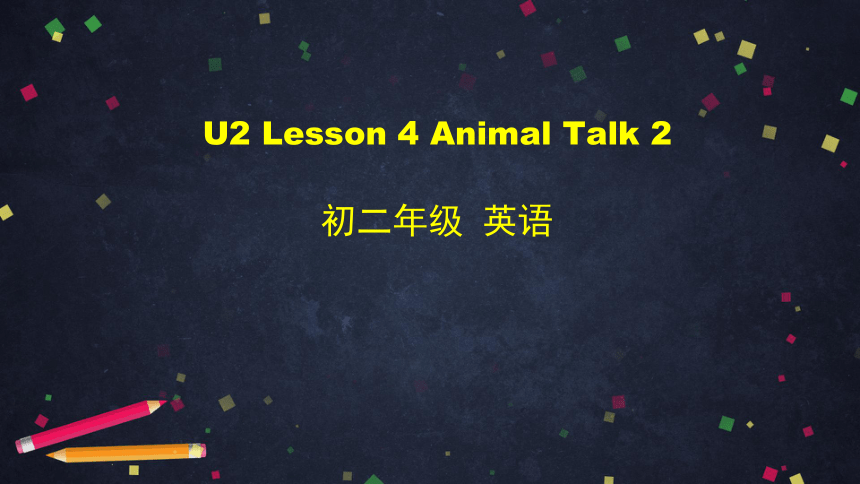 | |
| 格式 | zip | ||
| 文件大小 | 2.0MB | ||
| 资源类型 | 教案 | ||
| 版本资源 | 北师大版 | ||
| 科目 | 英语 | ||
| 更新时间 | 2020-05-05 09:16:35 | ||
图片预览



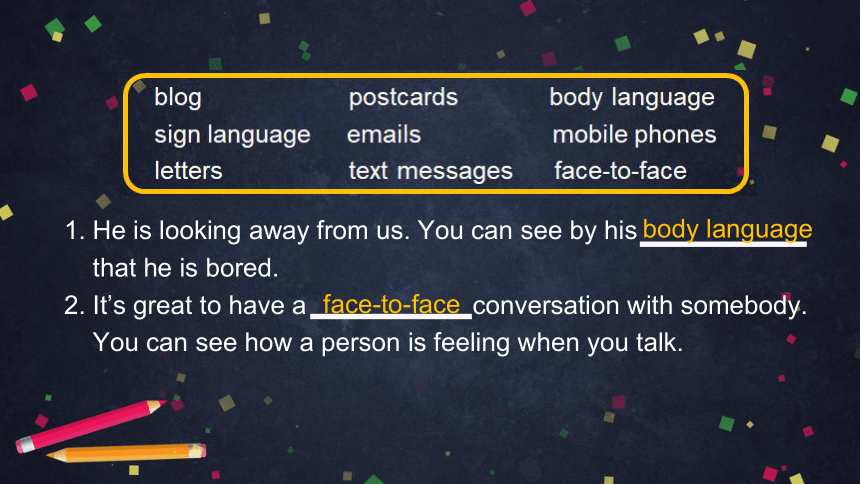
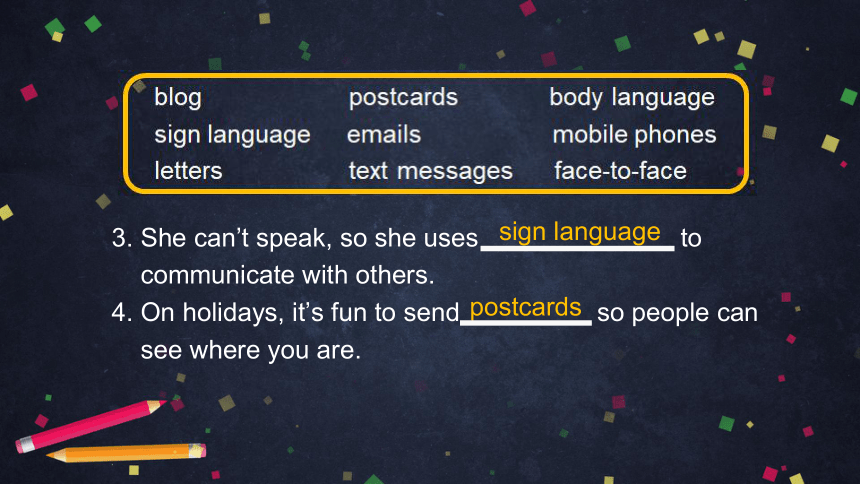
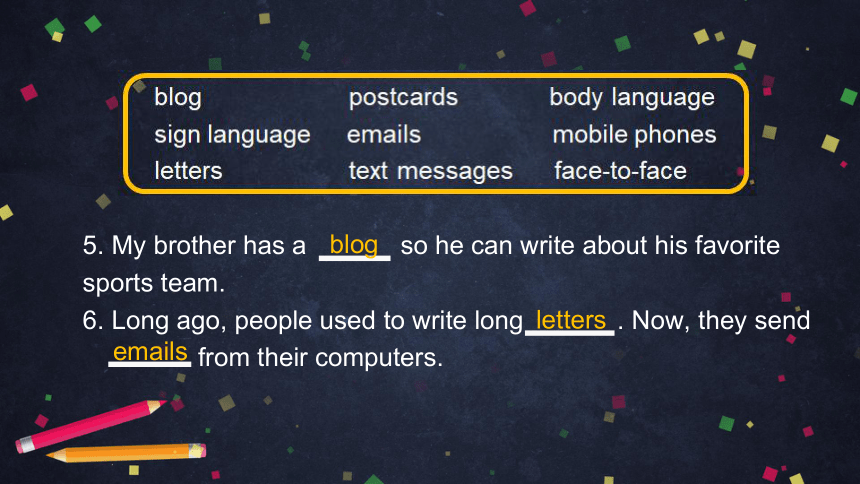
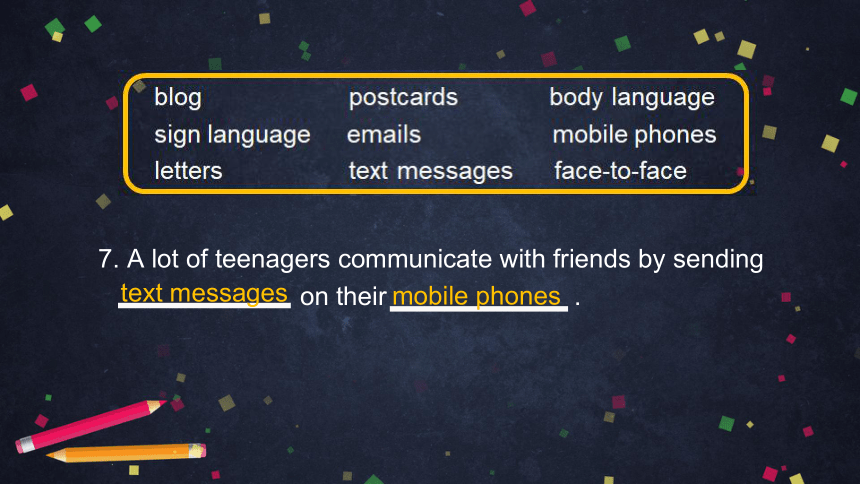
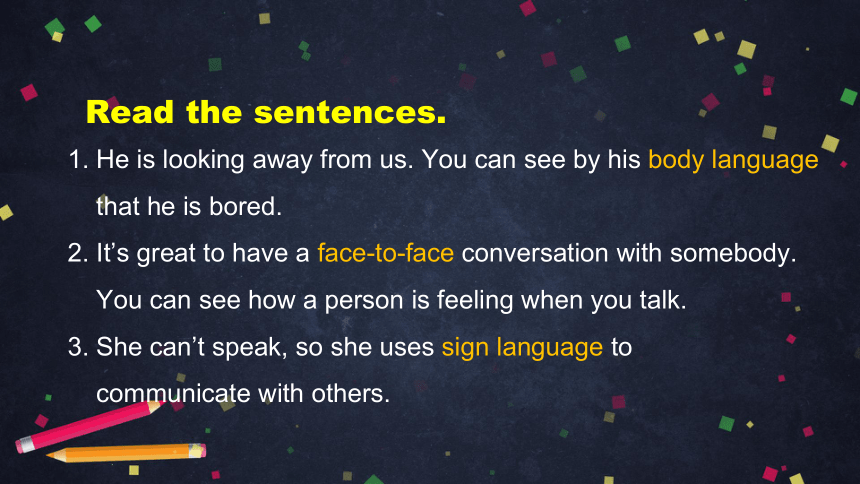

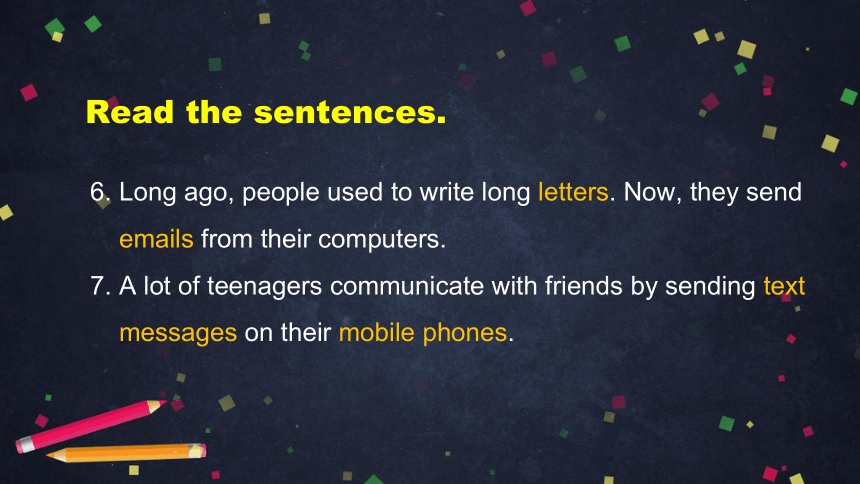
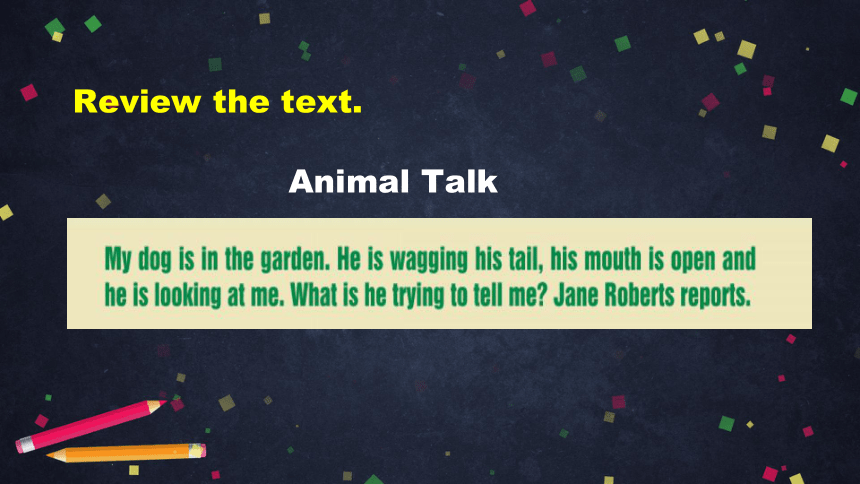
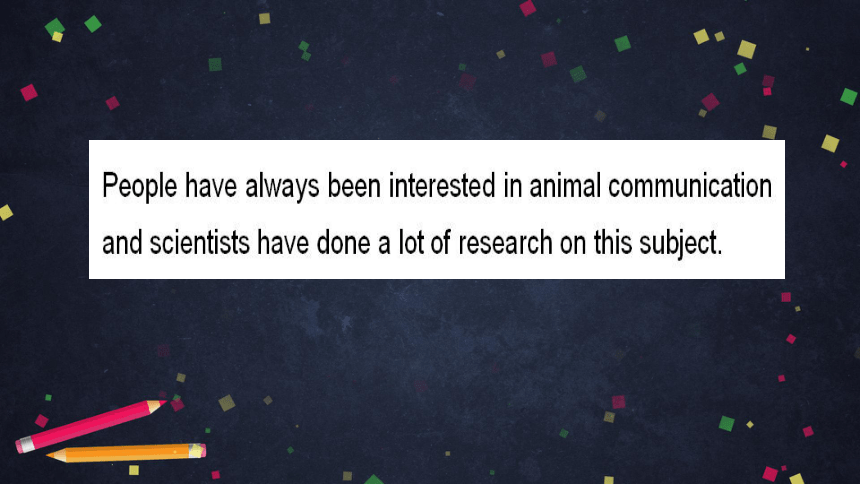
文档简介
(共65张PPT)
U2 Lesson 4 Animal Talk 2
初二年级 英语
Review the words.
blog
postcard
body language
sign language
email
mobile phone
letter
text message
face-to-face
博客
明信片
身体语言
手势语
电子邮件
手机
信件
短信
面对面的
Review the words.
P88-B Complete the sentences with the words in the box.
blog postcards body language
sign language emails mobile phones
letters text messages face-to-face
1. He is looking away from us. You can see by his
that he is bored.
2. It’s great to have a conversation with somebody.
You can see how a person is feeling when you talk.
body language
face-to-face
3. She can’t speak, so she uses to
communicate with others.
4. On holidays, it’s fun to send so people can
see where you are.
postcards
sign language
5. My brother has a so he can write about his favorite sports team.
6. Long ago, people used to write long . Now, they send
from their computers.
blog
letters
emails
7. A lot of teenagers communicate with friends by sending
on their .
text messages
mobile phones
1. He is looking away from us. You can see by his body language
that he is bored.
2. It’s great to have a face-to-face conversation with somebody.
You can see how a person is feeling when you talk.
3. She can’t speak, so she uses sign language to
communicate with others.
Read the sentences.
4. On holidays, it’s fun to send postcards so people can see
where you are.
5. My brother has a blog so he can write about his favorite
sports team.
Read the sentences.
6. Long ago, people used to write long letters. Now, they send
emails from their computers.
7. A lot of teenagers communicate with friends by sending text
messages on their mobile phones.
Read the sentences.
Animal Talk
Review the text.
Word Meanings
Vocabulary
mad
(adj.) 1. angry 2. crazy
sound
1. (n.) something that you can hear
2. (v.) to seem to you when you hear or read about sth.
subject
(n.) 1. a thing that is discussed or studied
2. an area of knowledge that is learned in a school
Choose the meanings they have in the text.
(adj.) 1. angry 2. crazy
1. (n.) something that you can hear
2. (v.) to seem to you when you hear or read about sth.
(n.) 1. a thing that is discussed or studied
2. an area of knowledge that is learned in a school
Scientist have done a lot of research on this subject.
Many other animals use sound to communicate.
When a cat puts its ears back, it is a bit mad.
Read the sentences.
Language Points
1. People have always been interested in animal communication and scientists have done a lot of research on this subject.
人们一直对动物如何交流感兴趣,科学家们已经就这一课题做了许多研究。
be interested in 对......感兴趣
is interested in
Language Points
e.g. She collecting stamps.
她对集邮感兴趣。
be interested in 对......感兴趣
2. Everyone has heard birds singing.
大家都听过鸟儿唱歌。
hear, see, watch, listen to
都可以接人称代词宾格+动词ing的结构。
Language Points
e.g. I her working in the garden.
我看见她在花园里干活。
We the band playing in the park.
我们曾在公园里听乐队演奏。
saw
listened to
Language Points
e.g. I don’t speak French German.
我既不会说法语也不会说德语。
3. They are either too low or too high for us.
(这些声音)对我们来说不是太高就是太低。
either... or...“或是....... 或是......”,“ 不是...... 就是......”。
either
or
Language Points
The three main methods of
animal communication:
by smell
by sound
by body language
Answer the questions.
1. How do scientists study animal communication?
2. What have scientists done with mice to let them help people?
3. How long have people been interested in animal
communication?
1. How do scientists study animal communication?
2. What have scientists done with mice to let them help people?
They have done a lot of research on this subject.
They have trained mice to find landmines.
Answer the questions.
3. How long have people been interested in animal
communication?
People have always been interested in animal communication.
People have been interested in animal communication for a long time.
Answer the questions.
Find out the similarities.
They have done a lot of research on this subject.
They have trained mice to find landmines.
People have always been interested in animal communication.
similarity 相似点
They have done a lot of research on this subject.
They have trained mice to find landmines.
People have always been interested in animal communication.
Find out the similarities.
similarity 相似点
Find more similar sentences from the text.
Dogs have helped the police for a long time, too.
Scientists have discovered that even ants use smell.
Everyone has heard birds singing.
Research has shown that many other animals use sound to communicate.
Animals have always used body language to communicate as well.
Find more similar sentences from the text.
现在完成时
主语+ 助动词+ 过去分词
I / You / We / They
He / She / It
learned
said
seen
been
has
have
Grammar Present Perfect Tense
现在完成时
1. 表示发生在过去但对现在有影响的动作。
e.g. Her last book has been a great success.
(结果:她现在是一个知名人物。)
I have lost my keys.
(结果:我现在开不了门。)
Uses 用法
2. 表示发生在过去,持续到现在的动作。常和since, for, all my life 等时间状语连用。
e.g. She has been a teacher for five years.
现在完成时
Uses 用法
结构:have / has + 过去分词
肯定句:
I / We / You / They have (=’ve) gone out.
He / She / It has (=’s) gone out.
现在完成时
Form 形式
结构:have / has + 过去分词
否定句:
I / We / You / They have not (=haven’t) gone out.
He / She / It has not (=hasn’t) gone out.
现在完成时
Form 形式
结构:have / has + 过去分词
一般疑问句
Have you / they gone out? Has he / she / it gone out?
Yes, I / we / they have. Yes, he / she / it has.
No, I / we / they haven’t. No, he / she / it hasn’t.
现在完成时
Form 形式
结构:have / has + 过去分词
特殊疑问句
How long have you / they been away?
How long has he / she / it been away?
现在完成时
Form 形式
过去分词的构成
分规则变化和不规则变化两种。不规则变化需逐个记忆,规则变化遵循以下原则:
(1) 一般情况下,在动词后加 -ed :
work - worked 工作???? laugh - laughed 笑
seem - seemed 似乎 look - looked 看?
jump - jumped 跳? play - played 玩
过去分词的构成
(2) 以-e结尾的动词后只加 -d:
close - closed 关?? like - liked 喜欢??
agree - agreed 同意
规则变化遵循以下原则:
过去分词的构成
(3) 以辅音字母加 y 结尾的动词,应将 y 改为 i 再加-ed:
study - studied 学习
carry - carried 带;扛??
try - tried 试;设法
规则变化遵循以下原则:
过去分词的构成
(4) 以重读闭音节或r音节结尾且末尾只有一个辅音字母的动词,要双写末尾的辅音字母再加-ed:
stop - stopped 停止??
drop - dropped 掉下
prefer - preferred 宁愿
规则变化遵循以下原则:
过去分词构成的不规则变化
ABC
ABA
ABB
AAB
AAA
动词原形 过去式 过去分词
speak spoke spoken
come came come
meet met met
beat beat beaten
read read read
课本P148-149 不规则动词表
现在完成时常与already, just, ever, never, yet等副词连用,副词置于have / has之后,或置于句尾。
e.g. I have never been to Peter’s house.
He has just bought a new car.
现在完成时及其常用副词和时间状语
现在完成时
already常用于肯定句,yet常用于疑问句和否定句,
ever常用于疑问句。
e.g. I have already finished my homework.
Have you repaired your bike yet?
Have you ever thought about becoming
an astronaut?
现在完成时及其常用副词和时间状语
现在完成时
现在完成时还可以与for+一段时间或since+某时间点连用。
e.g. I have studied here for three years.
I have studied here since 2010.
现在完成时及其常用副词和时间状语
现在完成时
Exercises
known shown found been heard
1. I have always interested in learning about animals.
2. Everyone has the sound of birds singing in the morning.
3. Scientists have about animal communication for a long
time.
been
heard
known
Write the correct words in the blanks. (P26-A)
4. Monkeys have that they can use their faces to express
their feelings.
5. The baby elephant has its mother. It followed her calls.
shown
found
Exercises
Write the correct words in the blanks. (P26-A)
known shown found been heard
I 1 (have) two dogs. Ginger 2 (be) in our family for seven years and Choc 3 (be) just two years old. They aren’t really friends. Ginger 4 (bite) Choc a few times and she often 5 (bark) at her.
Exercises
Complete the text with the verbs in present simple or present perfect. (P19-7)
have
has been
is
has bitten
barks
次数
At the moment, we are training them. I 6 (find) a good dog trainer and 7 (take) the dogs to her three times a week. She’s really great!
have found
take
Exercises
Complete the text with the verbs in present simple or present perfect. (P19-7)
频率
I have two dogs. Ginger has been in our family for seven years and Choc is just two years old. They aren’t really friends. Ginger has bitten Choc a few times and she often barks at her. At the moment, we are training them. I have found a good dog trainer and take the dogs to her three times a week. She’s really great!
Read aloud.
Use the words to make sentences in the present perfect.
(P19-8)
1. love animals / always / she
2. never / he / have a pet
3. Molly / be / for 10 years / my pet
4. have a pet tortoise / I / since I was 10 years old
1. love animals / always / she
2. never / he / have a pet
She has always loved animals.
He has never had a pet.
Use the words to make sentences in the present perfect.
(P19-8)
3. Molly / be / for 10 years / my pet
4. have a pet tortoise / I / since I was 10 years old
Molly has been my pet for 10 years.
I have had a pet tortoise since I was 10 years old.
Use the words to make sentences in the present perfect.
(P19-8)
Read aloud.
1. She has always loved animals.
2. He has never had a pet.
3. Molly has been my pet for 10 years.
4. I have had a pet tortoise since I was 10 years old.
Translation
Translate the sentences into English.(P89-Translation)
1.蚂蚁用气味告诉同伴食物的位置。
2.每个人都曾听过狗叫声。
3.科学家们已经发现,有些昆虫利用声音来交流。
4.当我的猫用尾巴绕着它自己坐时,它很开心。
5.有些狗能用它们出色的嗅觉寻找失踪的人。
1.蚂蚁用气味告诉同伴食物的位置。
2.每个人都曾听过狗叫声。
Ants use smell to tell other ants where the food is.
Everyone has heard dogs barking.
Translation
Translate the sentences into English.(P89-Translation)
3.科学家们已经发现,有些昆虫利用声音来交流。
Scientists have discovered that some insects communicate with sound.
Translation
Translate the sentences into English.(P89-Translation)
4.当我的猫用尾巴绕着它自己坐时,它很开心。
5.有些狗能用它们出色的嗅觉寻找失踪的人。
Some dogs use their fantastic sense of smell to find missing people.
When my cat sits with its tail around itself, it is happy.
Translation
Translate the sentences into English.(P89-Translation)
Read and check.
1. Ants use smell to tell other ants where the food is.
2. Everyone has heard dogs barking.
3. Scientists have discovered that some insects
communicate with sound.
Read and check.
4. When my cat sits with its tail around itself, it is happy.
5. Some dogs use their fantastic sense of smell to find
missing people.
Homework
1. Read the text and remember the new words and phrases.
2. Finish the exercises on workbook:
P26-E, P88-C.
Thank you!
U2 Lesson 4 Animal Talk 2
初二年级 英语
Review the words.
blog
postcard
body language
sign language
mobile phone
letter
text message
face-to-face
博客
明信片
身体语言
手势语
电子邮件
手机
信件
短信
面对面的
Review the words.
P88-B Complete the sentences with the words in the box.
blog postcards body language
sign language emails mobile phones
letters text messages face-to-face
1. He is looking away from us. You can see by his
that he is bored.
2. It’s great to have a conversation with somebody.
You can see how a person is feeling when you talk.
body language
face-to-face
3. She can’t speak, so she uses to
communicate with others.
4. On holidays, it’s fun to send so people can
see where you are.
postcards
sign language
5. My brother has a so he can write about his favorite sports team.
6. Long ago, people used to write long . Now, they send
from their computers.
blog
letters
emails
7. A lot of teenagers communicate with friends by sending
on their .
text messages
mobile phones
1. He is looking away from us. You can see by his body language
that he is bored.
2. It’s great to have a face-to-face conversation with somebody.
You can see how a person is feeling when you talk.
3. She can’t speak, so she uses sign language to
communicate with others.
Read the sentences.
4. On holidays, it’s fun to send postcards so people can see
where you are.
5. My brother has a blog so he can write about his favorite
sports team.
Read the sentences.
6. Long ago, people used to write long letters. Now, they send
emails from their computers.
7. A lot of teenagers communicate with friends by sending text
messages on their mobile phones.
Read the sentences.
Animal Talk
Review the text.
Word Meanings
Vocabulary
mad
(adj.) 1. angry 2. crazy
sound
1. (n.) something that you can hear
2. (v.) to seem to you when you hear or read about sth.
subject
(n.) 1. a thing that is discussed or studied
2. an area of knowledge that is learned in a school
Choose the meanings they have in the text.
(adj.) 1. angry 2. crazy
1. (n.) something that you can hear
2. (v.) to seem to you when you hear or read about sth.
(n.) 1. a thing that is discussed or studied
2. an area of knowledge that is learned in a school
Scientist have done a lot of research on this subject.
Many other animals use sound to communicate.
When a cat puts its ears back, it is a bit mad.
Read the sentences.
Language Points
1. People have always been interested in animal communication and scientists have done a lot of research on this subject.
人们一直对动物如何交流感兴趣,科学家们已经就这一课题做了许多研究。
be interested in 对......感兴趣
is interested in
Language Points
e.g. She collecting stamps.
她对集邮感兴趣。
be interested in 对......感兴趣
2. Everyone has heard birds singing.
大家都听过鸟儿唱歌。
hear, see, watch, listen to
都可以接人称代词宾格+动词ing的结构。
Language Points
e.g. I her working in the garden.
我看见她在花园里干活。
We the band playing in the park.
我们曾在公园里听乐队演奏。
saw
listened to
Language Points
e.g. I don’t speak French German.
我既不会说法语也不会说德语。
3. They are either too low or too high for us.
(这些声音)对我们来说不是太高就是太低。
either... or...“或是....... 或是......”,“ 不是...... 就是......”。
either
or
Language Points
The three main methods of
animal communication:
by smell
by sound
by body language
Answer the questions.
1. How do scientists study animal communication?
2. What have scientists done with mice to let them help people?
3. How long have people been interested in animal
communication?
1. How do scientists study animal communication?
2. What have scientists done with mice to let them help people?
They have done a lot of research on this subject.
They have trained mice to find landmines.
Answer the questions.
3. How long have people been interested in animal
communication?
People have always been interested in animal communication.
People have been interested in animal communication for a long time.
Answer the questions.
Find out the similarities.
They have done a lot of research on this subject.
They have trained mice to find landmines.
People have always been interested in animal communication.
similarity 相似点
They have done a lot of research on this subject.
They have trained mice to find landmines.
People have always been interested in animal communication.
Find out the similarities.
similarity 相似点
Find more similar sentences from the text.
Dogs have helped the police for a long time, too.
Scientists have discovered that even ants use smell.
Everyone has heard birds singing.
Research has shown that many other animals use sound to communicate.
Animals have always used body language to communicate as well.
Find more similar sentences from the text.
现在完成时
主语+ 助动词+ 过去分词
I / You / We / They
He / She / It
learned
said
seen
been
has
have
Grammar Present Perfect Tense
现在完成时
1. 表示发生在过去但对现在有影响的动作。
e.g. Her last book has been a great success.
(结果:她现在是一个知名人物。)
I have lost my keys.
(结果:我现在开不了门。)
Uses 用法
2. 表示发生在过去,持续到现在的动作。常和since, for, all my life 等时间状语连用。
e.g. She has been a teacher for five years.
现在完成时
Uses 用法
结构:have / has + 过去分词
肯定句:
I / We / You / They have (=’ve) gone out.
He / She / It has (=’s) gone out.
现在完成时
Form 形式
结构:have / has + 过去分词
否定句:
I / We / You / They have not (=haven’t) gone out.
He / She / It has not (=hasn’t) gone out.
现在完成时
Form 形式
结构:have / has + 过去分词
一般疑问句
Have you / they gone out? Has he / she / it gone out?
Yes, I / we / they have. Yes, he / she / it has.
No, I / we / they haven’t. No, he / she / it hasn’t.
现在完成时
Form 形式
结构:have / has + 过去分词
特殊疑问句
How long have you / they been away?
How long has he / she / it been away?
现在完成时
Form 形式
过去分词的构成
分规则变化和不规则变化两种。不规则变化需逐个记忆,规则变化遵循以下原则:
(1) 一般情况下,在动词后加 -ed :
work - worked 工作???? laugh - laughed 笑
seem - seemed 似乎 look - looked 看?
jump - jumped 跳? play - played 玩
过去分词的构成
(2) 以-e结尾的动词后只加 -d:
close - closed 关?? like - liked 喜欢??
agree - agreed 同意
规则变化遵循以下原则:
过去分词的构成
(3) 以辅音字母加 y 结尾的动词,应将 y 改为 i 再加-ed:
study - studied 学习
carry - carried 带;扛??
try - tried 试;设法
规则变化遵循以下原则:
过去分词的构成
(4) 以重读闭音节或r音节结尾且末尾只有一个辅音字母的动词,要双写末尾的辅音字母再加-ed:
stop - stopped 停止??
drop - dropped 掉下
prefer - preferred 宁愿
规则变化遵循以下原则:
过去分词构成的不规则变化
ABC
ABA
ABB
AAB
AAA
动词原形 过去式 过去分词
speak spoke spoken
come came come
meet met met
beat beat beaten
read read read
课本P148-149 不规则动词表
现在完成时常与already, just, ever, never, yet等副词连用,副词置于have / has之后,或置于句尾。
e.g. I have never been to Peter’s house.
He has just bought a new car.
现在完成时及其常用副词和时间状语
现在完成时
already常用于肯定句,yet常用于疑问句和否定句,
ever常用于疑问句。
e.g. I have already finished my homework.
Have you repaired your bike yet?
Have you ever thought about becoming
an astronaut?
现在完成时及其常用副词和时间状语
现在完成时
现在完成时还可以与for+一段时间或since+某时间点连用。
e.g. I have studied here for three years.
I have studied here since 2010.
现在完成时及其常用副词和时间状语
现在完成时
Exercises
known shown found been heard
1. I have always interested in learning about animals.
2. Everyone has the sound of birds singing in the morning.
3. Scientists have about animal communication for a long
time.
been
heard
known
Write the correct words in the blanks. (P26-A)
4. Monkeys have that they can use their faces to express
their feelings.
5. The baby elephant has its mother. It followed her calls.
shown
found
Exercises
Write the correct words in the blanks. (P26-A)
known shown found been heard
I 1 (have) two dogs. Ginger 2 (be) in our family for seven years and Choc 3 (be) just two years old. They aren’t really friends. Ginger 4 (bite) Choc a few times and she often 5 (bark) at her.
Exercises
Complete the text with the verbs in present simple or present perfect. (P19-7)
have
has been
is
has bitten
barks
次数
At the moment, we are training them. I 6 (find) a good dog trainer and 7 (take) the dogs to her three times a week. She’s really great!
have found
take
Exercises
Complete the text with the verbs in present simple or present perfect. (P19-7)
频率
I have two dogs. Ginger has been in our family for seven years and Choc is just two years old. They aren’t really friends. Ginger has bitten Choc a few times and she often barks at her. At the moment, we are training them. I have found a good dog trainer and take the dogs to her three times a week. She’s really great!
Read aloud.
Use the words to make sentences in the present perfect.
(P19-8)
1. love animals / always / she
2. never / he / have a pet
3. Molly / be / for 10 years / my pet
4. have a pet tortoise / I / since I was 10 years old
1. love animals / always / she
2. never / he / have a pet
She has always loved animals.
He has never had a pet.
Use the words to make sentences in the present perfect.
(P19-8)
3. Molly / be / for 10 years / my pet
4. have a pet tortoise / I / since I was 10 years old
Molly has been my pet for 10 years.
I have had a pet tortoise since I was 10 years old.
Use the words to make sentences in the present perfect.
(P19-8)
Read aloud.
1. She has always loved animals.
2. He has never had a pet.
3. Molly has been my pet for 10 years.
4. I have had a pet tortoise since I was 10 years old.
Translation
Translate the sentences into English.(P89-Translation)
1.蚂蚁用气味告诉同伴食物的位置。
2.每个人都曾听过狗叫声。
3.科学家们已经发现,有些昆虫利用声音来交流。
4.当我的猫用尾巴绕着它自己坐时,它很开心。
5.有些狗能用它们出色的嗅觉寻找失踪的人。
1.蚂蚁用气味告诉同伴食物的位置。
2.每个人都曾听过狗叫声。
Ants use smell to tell other ants where the food is.
Everyone has heard dogs barking.
Translation
Translate the sentences into English.(P89-Translation)
3.科学家们已经发现,有些昆虫利用声音来交流。
Scientists have discovered that some insects communicate with sound.
Translation
Translate the sentences into English.(P89-Translation)
4.当我的猫用尾巴绕着它自己坐时,它很开心。
5.有些狗能用它们出色的嗅觉寻找失踪的人。
Some dogs use their fantastic sense of smell to find missing people.
When my cat sits with its tail around itself, it is happy.
Translation
Translate the sentences into English.(P89-Translation)
Read and check.
1. Ants use smell to tell other ants where the food is.
2. Everyone has heard dogs barking.
3. Scientists have discovered that some insects
communicate with sound.
Read and check.
4. When my cat sits with its tail around itself, it is happy.
5. Some dogs use their fantastic sense of smell to find
missing people.
Homework
1. Read the text and remember the new words and phrases.
2. Finish the exercises on workbook:
P26-E, P88-C.
Thank you!
同课章节目录
- Unit 1 Technology and the Future
- Lesson 1 Schools of the Future
- Lesson 2 Online Life
- Lesson 3 Tomorrow's Jobs
- Communication Workshop
- Unit 2 Communication
- Lesson 4 Animal Talk
- Lesson 5 Meeting People
- Lesson 6 The Texting Generation
- Communication Workshop
- Unit 3 Festivals and Holidays
- Lesson 7 Chinese New Year
- Lesson 8 A Picnic
- Lesson 9 Thanksgiving
- Communication Workshop
- Unit 4 Dealing with Problems
- Lesson 10 Problem Page
- Lesson 11 Online Time
- Lesson 12 Generation Gap
- Communication Workshop
- Unit 5 Memories
- Lesson 13 A Daughter's Letter
- Lesson 14 Grandpa's Memories
- Lesson 15 Life in the 1950s
- Communication Workshop
- Unit 6 Detectives
- Lesson 16 A Detective Story (I)
- Lesson 17 A Detective Story (II)
- Lesson 18 The Mystery Writer
- Communication Workshop
